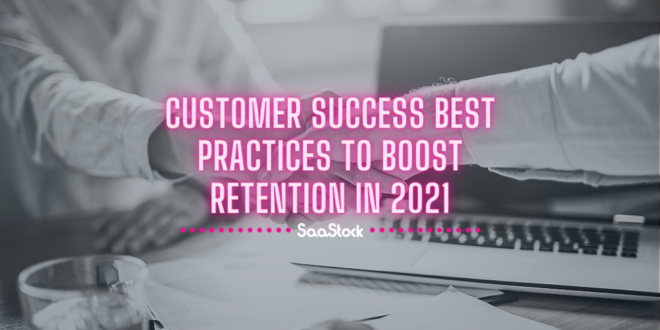In the early days of building your SaaS company, it’s tempting to put all your attention on acquiring new customers. However retaining and delighting existing customers is just as important for future growth.
For many growing SaaS companies, 2020 showed just how important our existing customers are. We saw many companies take big steps to help customers out who may have been affected by the coronavirus pandemic. For example, Buffer launched their customer assistance program and Hopin offered discounted pricing for event organisers affected by the pandemic.
Why? Because in SaaS, growth compounds. If you’re losing 100 customers a month, you have to replace them with 100 new customers to break even – and 101 to grow even a tiny bit. Given that the average cost of acquiring a new customer is 5 to 25 times more than retaining a current customer, that puts your company in a challenging (and financially unsustainable) position. Losing customers is costly, but keeping them for the long-term can be a real growth driver for your business. Therefore keeping your existing customers happy should be your number one priority.
In this post we’ll be looking at some customer success best practices to help you boost retention and lower churn. It covers:
- Why SaaS companies should make customer success a priority
- When you should start investing in customer success
- The role of customer success across the customer lifecycle
- Customer success best practices
- Understanding what success looks like
- Collecting and actioning customer feedback
- Customer success metrics
- Supporting ‘at-risk’ customers
- Helping your customers to help themselves
- Closing thoughts: Making customer success a priority for 2021 and beyond.
Why SaaS companies should make customer success a priority
Put simply, there are three main reasons why SaaS companies should make customer success a priority:
- Reduce churn – if you have a high customer churn rate, it will be difficult to acquire the number of new customers you need to grow.
- Increase Customer Lifetime Value (CLV) – if your customers are successful using your product, they’re less likely to churn. As well as staying customers for longer, each account can grow with the customer if there is a good opportunity to upsell to them.
- Unlock second-order revenue – second order revenue is revenue that comes from customer referrals, or when customers change jobs and start using your product again at their new company. Making your customers successful makes it more likely that they’ll recommend your product, or choose it when they move to a new company.
When should you start investing in customer success?
Put simply: the earlier you focus on customer success, the better.
“You Must Hire your First Customer Success Manager as a “Single Digit” Hire… Because getting just that one or two extra second order customers, those one or two extra upgrades, from happy existing customers, is the magic in SaaS. It compounds.” – Jason Lemkin
Investing time and resources in customer success early on means that in those early months and years you’re not solely reliant on customer acquisition as your only source of revenue, as you’re boosting your chances of retaining and upselling your existing customers.
The role of customer success across the customer lifecycle
Customer success plays an important role at many different stages of the customer lifecycle. While your sales and marketing teams own the customer acquisition phase, your customer success team owns the onboarding and retention phases. Here’s an overview of the different stages of the customer lifecycle that your customer success team will play a part in:
- Handover from sales – at some point, your customers will stop talking with their sales rep, and move over to speaking with your customer success manager. This is the very first step in the relationship between your customers and your customer success team.
- Onboarding – your onboarding process gets customers into your product, set-up, and using it. Many larger SaaS companies have dedicated onboarding teams within their customer success function, as they recognise the importance of setting your customers up for success early on.
- Renewal – the main focus for your customer success team is to help your customers get value from your SaaS product throughout their contract. Through engaging with feedback, they can not only improve customer retention and lower customer churn rates, but also provide an all-important ‘voice of the customer’ for the product team.
- Upselling – as well as retaining your existing customers, your customer success teams should look for opportunities to grow those accounts. The best times to do this could be at renewal, or earlier if there is enough usage data to suggest that a customer will get value from upgrading their account.
- Turning customers into advocates – customer success focuses on making your customers successful with your SaaS product. A successful customer is more likely to recommend your product to other people. An important part of the customer success role should be asking for testimonials from your existing customers, and turning your customers into advocates for your company.
- Off-boarding – you won’t retain every single customer. So off-boarding is an important step in the customer journey too. Your customer success team should treat this will as much importance as onboarding, as it affects the impression you’ll leave your customers with. A difficult off-boarding experience will leave a negative impression, and may even mean your customers recommend people to not use your product.
5 customer success best practices to boost retention
Customer success can be a real revenue driver for your SaaS business – if you get it right. We’re sharing five best practices to help your customer success function boost retention and reduce churn, driving real revenue growth for your company.
1) Understand what success looks like for your users
Customer success is a defined strategy for helping your customers get delight, satisfaction and value from using your product. But, how do you know if your product is really helping them? That they’re achieving results by using your product?
The most effective way to measure the value you’re delivering is to ask them. Collecting customer feedback is a key responsibility of your customer success team. Conducting customer interviews and running regular customer feedback surveys will help you develop a clear understanding of what success looks like for your customers.
2) Have a process for collecting and actioning customer feedback
There are many ways to collect feedback from your customers, such as:
- Net Promoter Score (NPS) surveys
- Customer Satisfaction (CSAT) surveys
- Online review sites like Trustpilot or G2
- In-app feedback
- Customer interviews
But it’s not enough just to collect that feedback. You need to then use it within your business. For example, you could use reviews from G2 as testimonials on your website, NPS and CSAT scores to track customer satisfaction and happiness, and insights from customer interviews to help you prioritise your product roadmap.
3) Get familiar with customer success metrics
Get to know the most important customer success metrics. This includes usage data as well as traditional customer success metrics. These are your early warning signs for if customers aren’t getting value from your product. Important customer success metrics include:
- Active users – This metric will tell you how many active users there are on your platform. If your customers aren’t using your product, they’re not getting value from it, and they’re at a higher risk of churning than customers who log in every week.
- NPS – Tracking your net promoter score is an easy way to see how happy your customers are with your product. Instead of fixating on the exact number, it’s more useful to see how it changes over time. Is your NPS trending up or down?
- Onboarding time – Tracking how long it takes customers to complete onboarding is crucial. If it normally just takes one hour for your customers to complete your onboarding process, but you see 50 customers spending a full day onboarding, that suggests they’re having trouble getting started with your product and may need some additional support to start getting value from it.
- Expansion revenue – Expansion revenue comes from cross-selling and upselling to existing customers, and is a big part of how customer success drives revenue for your business. This makes it one of the most important metrics for customer success teams to track.
4) Develop a process to support (and try to retain) ‘at-risk’ customers
‘At-risk’ customers are customers who are at risk of churning, or are close to their renewal date. You can identify customers who are at risk of churning based on product usage data, support tickets, and renewal dates.
It’s worth having a clear process in place to contact these customers, and offer them additional support or information they may need, to help them maximise the value they’re getting from your product ahead of their renewed date.
Once you’ve identified your ‘at-risk’ customers, you should:
- Get in touch! Try to arrange a call, as you will get much better insights from a conversation instead of over email.
- Get feedback from them – in their own words, how are they using your product? What’s working for them, and what’s not?
- Make sure they’ve got all the information they need. Let them know about any features you’ve added since they signed up, along with any top tips to make the most of those features. Additionally, you could give them a sneak peek at your product roadmap, so they can see what new additions are coming up in the next 3, 6 or 12 months that might make a big difference to the value they get from your product.
- Make it easy for them to stay – and for them to go. If a customer wants to leave, forcing them to dig through three navigation layers on your website to find the ‘cancel my subscription’ button won’t make them more likely to stay, but it will leave them with a much worse impression of your company.
5) Help your customers to help themselves
If your customers are finding challenges when using particular parts of your product, make it as easy as possible for them to solve their problems.
For example: make it quick and easy for them to contact your support team. This could mean having a dedicated support account on social media, having a support@ email address, and having a contact phone number for your support team, so they have several different ways to contact you for support.
It’s also worth building out a knowledge base that includes answers to the most common questions your support team gets asked, as well as guides to getting the most out of your product’s most popular features. This enables your customers to solve their own challenges and educate themselves on how to get the most value from your product.
Closing thoughts: Making customer success a priority for 2021 and beyond
If you’re looking to make customer success a business priority in 2021 and beyond, here are our four top tips:
- Make a dedicated customer success hire. If you’re a very early-stage SaaS business, it might make more sense for one of your co-founders to own the customer success function for a little while, but to maximise the value of your customer success function, a dedicated hire is essential. That hire will give you someone who is solely focused on customer retention, instead of splitting their focus across acquisition, retention and support.
- Customer success isn’t customer support. In smaller SaaS companies, your customer success team may be the ones providing support and troubleshooting for your customers, but as you grow you should recognise these as two different business functions. As Rav Dhaliwal said, customer success shouldn’t be viewed as an ‘everything department’. Customer support looks after your customers’ immediate needs, whereas customer success should focus on creating the conditions for long-term revenue growth.
- Treat customer success as a revenue generator, not a cost centre. As the famous Peter Druker quote goes, ‘what gets measured, gets managed’. Give your customer success team real targets based on revenue: have them own expansion revenue, with targets – just like your sales team.
- Develop your customer success processes. Things like: a process for handing-over new customers from your sales team to your customer success team; your onboarding and off-boarding processes; and a process for collecting and actioning customer feedback. Having clear processes will make it easier to scale-up your customer success team, as and when you need to.
Recurring revenue is at the heart of the SaaS business model, and relies on retaining customers as well as acquiring new ones. 2020 showed us just how important customer retention is for creating a stable foundation for business growth. Making customer success a priority can help you reduce churn and boost retention, making it easier for you to grow sustainably month after month.







